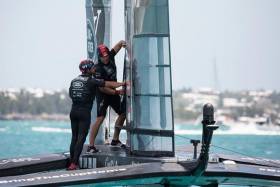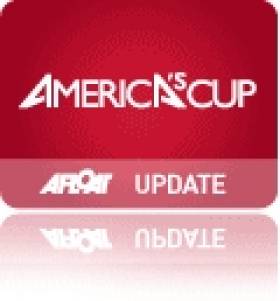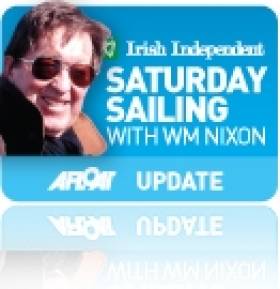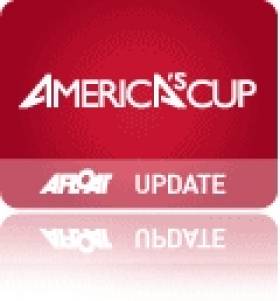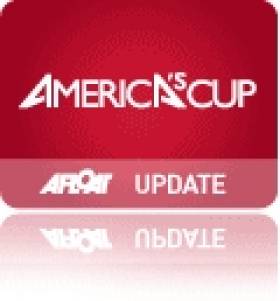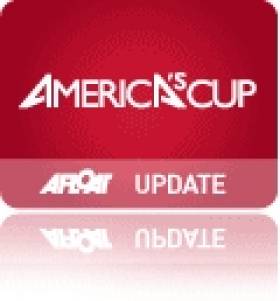Displaying items by tag: Americas Cup
After Mother Nature put paid to the scheduled first day of Louis Vuitton America’s Cup Challenger Playoffs action, Bermuda presented the four teams contesting the second stage of competition in the 35th America’s Cup with clear skies, perfect race conditions and good winds. Those conditions helped to produce a day of contrasts, with fantastic competition in one half of the Semi-Final table, and heartbreak for Sir Ben Ainslie and Land Rover BAR in the other.
The duels between Nathan Outteridge’s Artemis Racing and Dean Barker’s SoftBank Team Japan provided close competitive racing, both teams recording a win and a loss in their opening two races of the Louis Vuitton America’s Cup Challenger Playoffs Semi-Finals.
In contrast, a technical issue put paid to Sir Ben Ainslie and Land Rover BAR’s afternoon. There was drama right from the off in the battle between the British team and Peter Burling’s Emirates Team New Zealand, but an issue with the Land Rover BAR wingsail handed victory to the Kiwis.
The British team discovered a technical issue with their wingsail, sending them back to their base to try and take out the damaged wingsail and replace it with a spare, but they were unable to send their boat back out and had to forfeit their second race of the day. That meant that Emirates Team New Zealand won both races, their second one by default as Ainslie’s Land Rover BAR were unable to make the start.
“We’ve had a really tough day and unfortunately we suffered a breakdown in the wingsail control system,” conceded Ainslie.
“We got back to the dock to try and fit our spare wing but we just could not get back out in time for the second race.
“It is extremely disappointing to lose two races to Emirates Team New Zealand in that way but a positive to take is that we had some good gains in our speed and we will keep fighting all the way.
“These boats are really high-tech and we are pushing them to the limits. It was unfortunate what happened and we certainly did not need that today, but that’s life.
“The shore crew will be working into the night to fix the wing. They have been fantastic throughout the whole competition and no doubt we’ll come back stronger tomorrow.”
In the race one pre-start sequence Burling out manoeuvred his opposite number Ainslie, Emirates Team New Zealand timing their approach to the start line to perfection, allowing them to gain the early advantage over Land Rover BAR heading towards the first mark. Press reports before the race suggested Ainslie would be ultra-aggressive in the pre-start, but he was bettered by Burling whose team pulled out into a six second lead at the second gate, before a dramatic moment ended the race before it had really started.
Heading out of gate two, and into the third leg, Sir Ben Ainslie’s Land Rover BAR ACC boat suddenly came off its foils and into the water, halting any momentum and allowing Emirates Team New Zealand to race ahead into a huge lead.
As the British team discussed the issue with their race boat out on the water it was quickly clear that their race was over. Ainslie radioed through to the on-water ACRM umpires to confirm that Land Rover BAR would retire from the race, ending their race one challenge and handing victory to Emirates Team New Zealand.
The damage suffered in the first race ultimately ended Land Rover BAR’s involvement in the day’s action. Sir Ben Ainslie’s team were unable to return to the start line for their second scheduled Louis Vuitton America’s Cup Challenger Playoff Semi-Final against Emirates Team New Zealand.
As a result, Peter Burling’s team only had to cross the start line in the scheduled third race of the afternoon to clinch victory, which they duly did, taking a two-point advantage over the British team in the process.
“It looked like we were in for a really exciting race against Land Rover BAR in the first race until they had that major failure,” said Emirates Team New Zealand helmsman Peter Burling, who has urged his team to stay focused despite enjoying a 2-0 lead over Sir Ben Ainslie’s team.
“It’s never nice to see that sort of thing happen to anyone but unfortunately that’s part of sailing.
“Obviously for us it is great to take the two points and enjoy what proved an easy day for us.
“However, the pressure is certainly not off us. We’ve seen in the races so far that the teams are so close and things can change quickly so we have to stay focused going forward.”
The second race of the day, and the first Louis Vuitton America’s Cup Challenger Playoffs Semi-Final encounter between Dean Barker’s SoftBank Team Japan and Nathan Outteridge’s Artemis Racing, proved less dramatic but no less enthralling as the Japanese team sealed their important first point against the Swedes.
After an even start, it was Nathan Outteridge’s Artemis Racing who stole the early lead, reaching the first mark narrowly ahead of the Japanese team.
However, the tides turned on leg three of seven, as a perfectly executed manoeuvre from Dean Barker saw him pass Nathan Outteridge as SoftBank Team Japan snatched the lead heading into gate three.
It was an advantage they would not relinquish for the remainder of the race, maintaining a steady lead over Artemis Racing with Dean Barker holding his nerve to bring his SoftBank Team Japan over the finish line 23 seconds ahead of their rivals.
The scheduled third race of the afternoon was due to be Emirates Team New Zealand against Land Rover BAR, but the damage to Sir Ben Ainslie’s team’s wingsail put paid to the action on-water, so attention turned to Barker vs Outteridge, round two.
Having lost the first encounter, Nathan Outteridge came back fighting to clinch a crucial win and level the scores at 1-1.
In contrast to the first encounter, it was Dean Barker who won the pre-start duel to claim the early advantage, with Nathan Outteridge trying and failing with a penalty call.
However, Barker was not to have it his own way as the race progressed into a topsy-turvy encounter with multiple lead changes, particularly during leg five when Artemis Racing came out of the gate five turn with a slender lead.
Under pressure, Dean Barker made a costly and ultimately crucial mistake, tacking poorly to all but end SoftBank Team Japan’s challenge and hand the advantage to Artemis Racing.
It was a gift that Outteridge seized upon, opening up a clear gap on leg six, rounding the final mark before crossing the finish line safely ahead of his rival to level the scores and leave the tie finely poised heading into tomorrow’s scheduled races.
“We had a really good first race and we were delighted with our sailing to take that first victory,” said SoftBank Team Japan helmsman Dean Barker.
“In the second race, we had a good start and were leading comfortably but a bad gybe from ourselves allowed them (Artemis Racing) to take control.
“It is never ideal to have a poor manoeuvre like that but we go away and refocus on what we need to do going forward.”
In reply, Artemis Racing’s helmsman Nathan Outteridge was satisfied with his team’s performance overall in what proved a close battle against Dean Barker.
“I’m very happy overall to get a point on the board,” said Outteridge.
“We had two tough battles but we sailed really well and I thought the pace of the boat was great throughout the day.
“I think we were unfortunate to lose the first race because we let them through but in the second race we kept the hammer down and took a nice win.
“We backed ourselves and got an important win and that is really pleasing to take away.”
The second practice race day today in Bermuda, ended in a heavy pre start collision when Land Rover BAR collided with Emirates Team New Zealand after they had been comprehensively shut out in last stages of the pre start sequence.
Peter Burling on the helm of Emirates Team New Zealand had done a good job securing the favoured leeward end of the line and shutting out Sir Ben Ainslie and the Land Rover BAR boat.
"It was a bit of a shame in the last pre start we had the leeward end of the line pretty locked down, Ben was quite late and just ran straight into the back of us." said helmsman Burling. "Just unnecessary a week out from the America's Cup we are all here to learn and it's a shame we have a pretty big metre dent now in the back of our nice boat."
As for the damage:
"It went straight in under the media pod with his windward bow and right down the inside of the leeward hull, so there is a pretty good dent there. You can definitely see if has punctured right into the cockpit right around where my steering wheel is." continued Burling
Emirates Team New Zealand CEO Grant Dalton upon assessing the damage, "We know Ben well, he is a good guy but frustration is obviously getting to him and the red mist came down and it's a lot of damage in a time we can't afford it."
Other than the damaged sustained it was a positive day for Emirates Team New Zealand, winning both of the races it sailed against Land Rover BAR earlier in the day and Groupama Team France after both Oracle and Softbank Team japan refused to race against the kiwi team.
It's the direct link between Sir Ben Ainslie and the boat built to bring the America's Cup home; the steering wheel that Ainslie will be holding as he strives to drive Land Rover BAR's America's Cup Class boat to success this summer in Bermuda. And the wheel is a direct result of a long partnership with the team's title and exclusive innovation partner, Land Rover. This remarkable piece of technology has been in development for the past 18 months within the Technical Innovation Group (TIG), chaired by the management and technology consultancy PA Consulting Group, and is now being revealed ahead of the start of racing on 26th May.
The control of an America's Cup Class foiling multihull is a two-dimensional problem. The wheel doesn't just turn the boat left and right as it would do on a conventional boat, but it also controls the boat's height and attitude above the water, through control of the power delivered from the hydrofoils.
The hydrofoil does what it says on the tin – hydro-foil – a foil in water. Just like the aerofoil – the wings that lift planes into the air – the hydrofoils deliver lift, in this case, they push the boat up and out of the water.
So the steering wheel must allow Ainslie to both steer the boat, and control the hydrofoils so he can 'fly' the boat fast and smooth above the water. It's a bit like tapping your head and rubbing your tummy. There are two sets of controls to keep the boat on the right track both horizontally and vertically; left and right, up and down. The left and right part was straight-forward, that's what the steering wheel does. It was the up and down that needed creativity, innovation and cool technology.
The Human Machine Interface (or HMI) is an area in which Jaguar Land Rover (JLR) have considerable experience, technical expertise and a reputation for innovation in their cars – as anyone who has driven the latest Discovery will know. No one with an interest in safety wants to take their eyes off the road for any longer than they absolutely have to, and good HMI can allow you to complete a task without looking, with the minimum of mental effort.
Ben Ainslie required exactly the same of the hydrofoil control on the wheel of the ACC boat. There were many possible ways it could be done; from switches to dials, gear shifts to twist grips. Some could be quickly discarded, others were tried, developed, prototyped for testing and simulation. The best of the ideas went forward with working prototypes built that could be tested on the boat. Of these, there was a clear winner – the paddle shift.
The analogy with the paddle gear shift on a performance car is a good one. The hydrofoil needs to be adjusted in steps as the boat accelerates and decelerates, just as you would change gears in a car as you accelerate or decelerate. Go faster, tap towards you; go slower, tap away from you, each shift attuned to the demand for the optimum performance of the boat, just as a car driver seeks to match the gear to the speed and engine revs for maximum efficiency
Rick Tomlinson 2016 Sailing Calendar Is Ideal Christmas Gift
The 28th edition of the highly acclaimed Rick Tomlinson Portfolio calendar is now available directly from the Afloat.ie marketplace site HERE. The ideal Christmas gift for the sailor in your life features 12 spectacular images from recent assignments around the world.
This year's pictures include action from The Volvo Ocean Race at Cape Horn, the Royal Yacht Squadron Bicentenary Regatta, Sir Ben Ainslie’s Americas Cup challenge, sailing in Greenland, plus other action and art from the international racing circuit.
Action and art has always been Rick’s style, “Each picture will hang on the wall for a month and offer the viewer something that perhaps they didn't see on the first look” says Rick, “my particular favourite this year is the shot of Brunel off Cape Horn.”
Rick has raced in 4 Whitbread Round the World Races, on Drum, The Card, Intrum Justitia and Team EF. Photographs taken onboard Drum started his career, becoming one of the most highly acclaimed marine photographers in the world. High profile projects include the Volvo Ocean Race, Americas Cup, and many SuperYacht commissions. He was recently the Official photographer for Team SCA.
Rick works from his gallery in Cowes - Isle of Wight, and travels the world on assignments for the worlds leading events and yachts.
Did The America's Cup Destroy Belfast Lough Sailing?
#americascup – The 35th America's Cup series will be staged in Bermuda in 2017, and already the first team – Ben Ainslie Racing – is starting to settle into its base in the islands at the beginning of a developing process which, it is hoped by locals, will contribute significantly and sustainably to an economy which is by no means as prosperous as the popular image of Bermuda would suggest.
Yet past experience of being involved with the America's Cup circus suggests that while there are definitely immediate and highly visible benefits, they're ephemeral and are more than offset by a hidden but very definite downside. And the pace of the event at its peak is at such a level that almost immediately afterwards there's a sense of anti-climax and recrimination which can poison a sailing centre's atmosphere for years. W M Nixon considers how sailing's most stellar event affected Irish sailing, looks at a more recent continuation of this story, and then takes up the tale of an old boat whose class's health suffered collateral damage from America's Cup fallout.
It was while tracing the story of Tern, a 37ft William Fife-designed Belfast Lough One Design built by John Hilditch of Carrickfergus in 1897, that we stumbled into what is arguably an example of the America's Cup having a seriously damaging effect on local sailing.
Somehow or other, Tern has survived, and is currently being restored to international standards in Palma, Mallorca. But it was when a couple involved with her restoration came to Ireland shortly after Christmas to spend some time researching her history that we had to face the fact that while Belfast Lough's involvement with the America's Cup is seen as a glamorous and still-celebrated era, as far as everyday sailing is concerned it did little but harm.
The context is intriguing. Belfast in 1897 was the Mumbai of its day. From a population of around 80,000 in 1850, by 1910 its unprecedented expansion through massive industrial innovation and development, built largely around ship-building and linen manufacturing, had seen numbers soar towards 300,000. The city was a byword for pollution, over-crowding, and ill health, but equally it was noted as a place where anyone with energy and an innovative manufacturing idea was expected to have made their fortune within ten years, and around three or four years to start reaching towards wealth was seen as a not unreasonable aim.
In such a frenetic and ambitious atmosphere, sailing on Belfast Lough developed apace, and it developed ambitiously and competitively for all that the lough, while providing splendid sailing water, lacked any really good natural anchorages. New boats and new boat types appeared with bewildering rapidity, and a sort of one design keelboat concept was being accepted by the early 1890s in order to make good racing accessible to keen young men at a reasonable price. There may have been much underlying wealth about, but spending it on extravagances like large and expensive yachts was frowned upon.
By 1896 a young whiskey distiller called James Craig (he later became Lord Craigavon) was promoting the idea of a strict One Design keelboat around 23ft LOA, and about 16ft LWL, designed by the great William Fife in Scotland, but built on the lough by John Hilditch at his Carrickfergus boatyard. As the pioneer of the concept in the locality, Craig called the new class the Belfast Lough No. 1 OD, but the first boat to the design, his own Fugitive, was barely finished before the One Design keelboat ideal was taken up with enthusiasm by another group which decided they wanted something to the same concept, but much larger.
These new boats, the first of which were rapidly built in time for the 1897 season, were almost exactly enlarged versions of Fugitive, but were all of 37ft overall and 25ft waterline. In a case of Might is Right, the bigger boats now became the Belfast Lough Number Ones, while Fugitive and her sisters were demoted to Number 2, and by the early 1900s they'd slipped still further to become the Number 3s when yet another class appeared, this time around 31ft LOA.
There were enough of the new 37ft Number Ones afloat to make a real impact on Clyde Fortnight in 1898, and as they were well able to sail across Channel to do so, they were arguably the world's first offshore one design. The previous year, some had visited Dublin Bay, where they so impressed the locals that they were the inspiration for the Dublin Bay 25s, to the same lines but built to a higher specification and with lead ballast keels, rather than the Belfast Lough boats' cast iron keels.
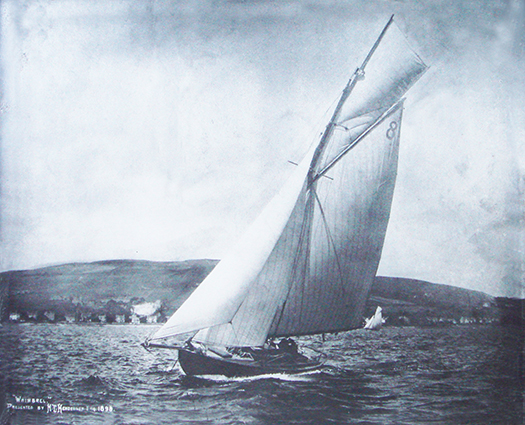
Whimbrel on the Clyde in 1898. They'd the potential to be the world's first offshore one design, but offshore racing hadn't yet been invented. Whimbrel is currently undergoing restoration in Bordeaux. Photo courtesy Gordon Finlay/RUYC
By the middle of the 1898 season, the Belfast Lough One Designs were in all their glory, and our header photo from that season shows a class which surely promised at least a decade of great racing. Yet their peak years barely stretched beyond the turn of the century, and within five years they scarcely existed as a class. Well before the Great War broke out in 1914, they were starting to spread near and far in a scattering which was to continue post war and in most cases ended up in their eventual demise. But remarkably, two have survived and both are undergoing restoration, Whimbrel Number 8 in Bordeaux and Tern, number 7, in Mallorca.
Patricia O'Connell and Alan Renwick live in Palma where he is a master craftsman with Ocean Refits while she – a former Honorary Secretary of a Georgian preservation society in Dublin – has undertaken the tracing of Tern's story, as Tern's restoration is Alan's current project. They arrived in Dublin in the dying days of 2014, and by the time they headed back to Palma well into January, they'd spent time in Cork and Northern Ireland following the old boat's elusive trail, and had also called in Howth to see Ian Malcolm's Howth 17 Aura, which was built in Hilditch's yard within a year of the construction of Tern.
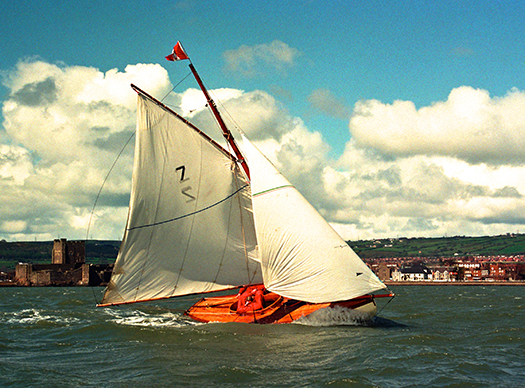
Still going strong. The 1898 Hilditch-built Howth 17 Aura off Carrickfergus Castle for her Centenary, April 1998. With her sister-ships, she then sailed the 90 miles home to Howth. Like Tern, she is number 7 – and like Tern, there's an element of confusion with sail number 2. Photo: David Jones
The original five Carrickfergus-built Howth 17s still sail together as part of a thriving class of twenty Howth 17s. But the impressive class of eight Belfast Lough One Designs from the same era have been remembered for more than a hundred years only as photos on the walls of the Royal Ulster Yacht Club. What went wrong?
The America's Cup – that's what went wrong. In the early years of sailing's premier trophy, there was remarkable Irish involvement. After the schooner America won it with a race round the Isle of Wight in 1851, it took a while to establish a format for races to try and wrest it back from the New York Yacht Club in contests in America. During the 1870s, there were three challenges – two from Britain and one from Canada. Then in the 1880s there were three from Britain and one from Canada, the final one from Britain in 1886 being through the Royal Northern YC of Scotland, but that was because the owner's wife was Scottish – the husband was Lt William Henn whose family home was on the north shore of the Shannon Estuary.
But while the Henn family's hefty cutter Galatea was another unsuccessful challenger, at least she was seen in the waters of the Shannon Estuary. Yet although the first two challenges in the 1890s were by racing machines owned by a yachtsman whose ancestral pile was also on Shannonside, neither boat was seen anywhere near Adare Manor, the home of Lord Dunraven on the south side of the Shannon Estuary, whose two campaigns in 1893 and 1895 were unsuccessful and increasingly acrimonious.
With the passage of time, it becomes increasingly clear that Dunraven got a decidedly raw deal. But in the feverish atmosphere of rapid economic expansion in the 1890s, the world was more interested in pushing ahead with new projects rather than putting right old wrongs. Someone who saw the developing publicity and business potential in the America's Cup was Thomas Lipton, the Scottish-born grocery magnate whose American empire was thriving with a combination of his sheer love of hard work, and gift for publicity.
Lipton had noted the extraordinary level of public interest in Lt & Mrs Henn's "family" challenge in 1886 – they'd actually lived on board the Galatea at he time. But much more importantly, he'd noted the international crisis which arose from the Dunraven affair, and cannily realized that anyone who could smooth the waters with a good-tempered America's Cup challenge would attract acres of favourable coverage, regardless of the actual result.
That said, as a highly competitive individual, there's no doubting he was keen to win. But even though all five of his yachts called Shamrock making his America's Cup challenges between 1899 and 1930 were unsuccessful, with some being much more closely fought than others, he remained resolutely good humoured throughout, and expansion of his retail empire continued unabated. But what's less widely known is that while the America's Cup Shamrocks were numbered I to V, there was a sixth Shamrock, an un-numbered 23 Metre, which raced as his private yacht. It's said that when she didn't perform as well as she should have, the old man could be very grumpy indeed.
But that's all in the future. Here we are in the latter half of the 1890s, and on Belfast Lough this wonderful new class of 37-footers is spreading its wings, thriving on the fact that although the owners lived all round the lough and were members of one yacht club, the Royal Ulster YC founded 1866 and given the "Royal" in 1869, they could feel at home wherever their boats happened to be, as the RUYC had no clubhouse. This was a true sailing club, fixed only to good sailing water, and with the Belfast Lough Number Ones they could sail it well.
It was too good to last. Thomas Lipton was a man in a hurry. He knew that he needed a yacht club of international standing through which to make his first America's Cup challenge. But as he was of humble birth and very much in trade instead of benefitting from inherited wealth, there were few yacht clubs open to him. However, his parents had come from Monaghan, not only in Ireland but particularly in Ulster. In the can-do atmosphere of Belfast in the 1890s, it was indicated that the Royal Ulster might be receptive to his interest. He was soon a member, and plans were roaring ahead for an 1899 Challenge with Shamrock I.
But the RUYC had taken a cuckoo into its nest, or rather its virtual nest. It emerged that a virtual nest was not enough for the aspirations of a serious America's Cup challenger, he needed a real nest. Lipton was soon insisting that his America's Cup challenge, now irreversibly under way, would required the RUYC to have a proper clubhouse impressively sited above the waters of Belfast Lough where it was assumed he would very soon be the defender in the America's Cup.
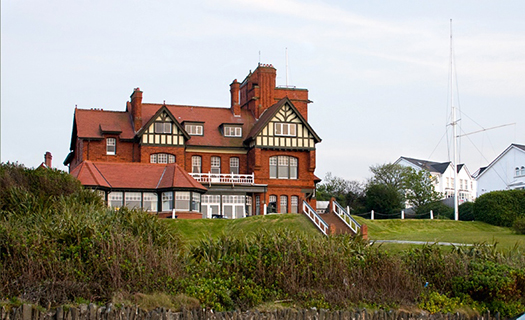
The new RUYC clubhouse was completed at the behest of Thomas Lipton in 1899 after just 18 months work.
And he got his way. An impressive arts and crafts tower-topped clubhouse design was drawn up by James Craig's brother, the architect Vincent Craig, and the new RUYC clubhouse was opened in April 1899, having been built in 18 months flat. Well – not quite flat. They were in such a hurry for completion that there wasn't the time to entirely level the hillside site on the Bangor waterfront where the new clubhouse was built, and even today the ground floor is on two or three different levels.
That said, it's an impressive building to have been put up in such a short time, and somehow they achieved a sort of instant antiquity with it – today it seems much older than its 116 years, and it has always been thus.
But antique or otherwise, it doesn't seem to have been desired by all the members. There were 150 of them, yet only 30 contributed directly to the cost of the new clubhouse. And others took their sailing elsewhere. We live in hope of finding letters or a sailing diary from this period which will tell us what was really going on, for official club committee papers only cover what was on the agenda and recorded in the minutes. Thus even if there was an almighty row going on about the very fact of the somewhat cavalier building of this new clubhouse, at the time it would have been something known to everyone, and talked about by everyone, yet not written down simply because everyone knew of it, and it didn't happen to be directly pertinent to the business of the day. And anyway, once the clubhouse was in being, that was that – the best thing was to get on with living with it.
Yet the fact is that a distinct division arose in sailing along the south coast of Belfast Lough. The conspicuous Royal Ulster YC in Bangor became the public face of yachting in the area. But further up the lough at Cultra beside a roadstead anchorage, what had been a modest canoe club developed in 1899 into an amalgamation of the Ulster Sailing Club with the Cultra Yacht Club to become the North of Ireland Yacht Club, and by 1902 – by which time Lipton had already unsuccessfully challenged twice for the America's Cup through RUYC – the new place at Cultra had become the RNIYC, with a modest clubhouse aimed exclusively at serving its members' sailing needs rather than following grandiose ideas of international yachting campaigns for plutocrats who were only very seldom about the place, if at all.
Inevitably some of the best sailing men in the north were involved with this move to Cultra where many had always anchored their boats in any case, and others had followed. Whether or not the active membership of the RUYC was seriously depleted we can only guess. But the fact is that the relatively small membership of a provincial yacht club had somehow to find, within its membership, the essential people with the necessary talent and experience to provide the back up committee and officer services for Lipton's America's Cup Challenges, with the next one coming along as soon as 1903.

America's Cup design development 1851 to 1930. The Challenge Committee of the RUYC may have come on the scene 48 years after the era of the schooner America, but they still had to cope with the challenges posed by the design development from boats like Reliance in 1903 to the J Class Rainbow in the 1930s.
The drain on RUYC personnel resources was heavy in an era when time-consuming Transatlantic voyages by ship were required for the challenger's committee to meet with the committee of the defending New York Yacht Club. Something just had to give, and it seems to have been the level of personal sailing within RUYC, and particularly with the Number One Class.
The new RNIYC setup at Cultra was establishing its own modest new 22ft OD class, the Linton Hope-designed Fairy Class (also built by Hilditch), so they may well have seen the much larger Number Ones as simply too large, and tainted by the new vulgarity of the RUYC. Whatever the reason, the Belfast Lough Number One Class was a brilliant flame which burned only briefly as a class, even though the boats survived individually with most of them becoming fast cruisers.
But as for the America's Cup, it continued on its melodramatic way, with skulduggery par for the course. After 1903's unsuccessful challenge, when Shamrock III found herself ill-matched against the hyper-giant Reliance, the RUYC committee may have returned home to recuperate and gather strength for Lipton's next campaign. But he was scheming other ideas, and it has been only relatively recently discovered that, unbeknownst to RUYC, he was in preliminary negotiations with the Royal Irish YC on Dublin Bay to organise his fourth challenge.
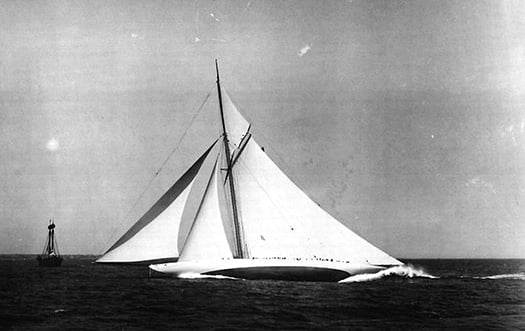
Lipton and the RUYC thought they'd an impressive boat with the Fife-designed Shamrock III in 1903, but this is what they came up against in America – mega-boat Reliance
From a purely commercial point of view, you can understand his thinking. The formerly despised Irish community in the US was expanding rapidly in numbers and prosperity by 1904. Coming in with a challenge through the Royal Irish Yacht Club would hit more market targets than the narrower appeal of a Royal Ulster challenge. It was crude but shrewd business thinking. But fortunately for goodwill in the sailing community, nothing came of it. Challenge 4 through RUYC was slated for 1914, but with the Great War breaking out it was held off - with the radical and very promising Shamrock IV designed by Charles E Nicholson stored in the US – until 1920, with Shamrock IV defeated by the narrowest margin. And then in 1930 came the last challenge, the first with the J Class, but again there was defeat, this time for Shamrock V.
And thus 1930 saw the end of the Royal Ulster YC's tumultuous three decades affair with the Holy Grail of sailing. Since then, other clubs have had their collective finger burnt by the America's Cup. But it usually promises more than it gives. Most recently, sailing has been bluntly reminded of its limited appeal as a spectator sport, even when packaged as America's Cup Plus. The 34th series in San Francisco may have provided some of the most exciting racing ever seen in the event's 164 year history. It made great television for aficionados. And it may have attracted 150,000 shoreside spectators over the length of the series. But let's get it into perspective. San Francisco's Number One tourist attraction is Alcatraz. This island with its former prison fortress linked to the likes of Al Capone and other adornments of American society attracts around a million visitors a year. No matter which way you slice the numbers, that's quite a few more than the America's Cup, it doesn't cost nearly as much, and it's much less trouble to run.
Which goes some way to explain why those of us who live for this crazy old vehicle sport of ours retreat into the happy dreamworld of old boats and their winding journeys through life, often to a wonderful re-birth. And the story of Tern is a classic of its kind. From Belfast Lough she headed some time or other to Cork, we don't quite know when, but we do know she was converted to a yawl for greater ease of handling in 1914. And she was certainly in Cork in the 1920s and 1930s owned seemingly by a loose syndicate, as different owners appear at different times depending on what event she is being entered for, and in 1929 she was one of five yachts taking part in the Irish Cruising Club's Founding Cruise-in-Company to Glengarriff, owned by Capt P F Kelly.
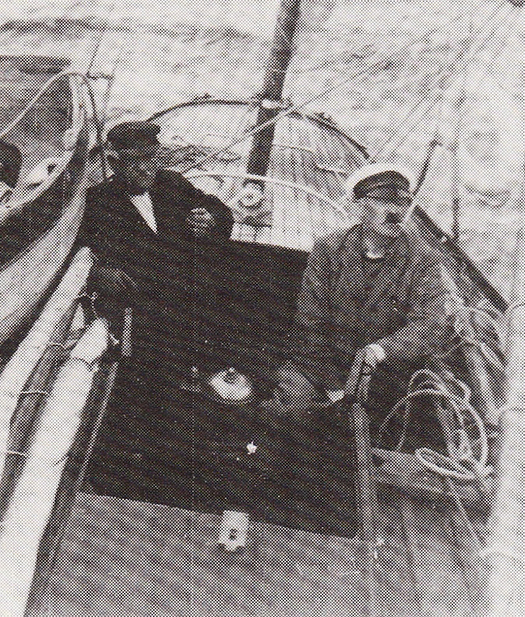
Happy days. Aboard Tern in cruising style, complete with enormous dinghy on the starboard deck, on her way to the founding of the ICC in Glengarriff in 1929 with Captain Kelly and Dr Dan Donovan enjoying the sail
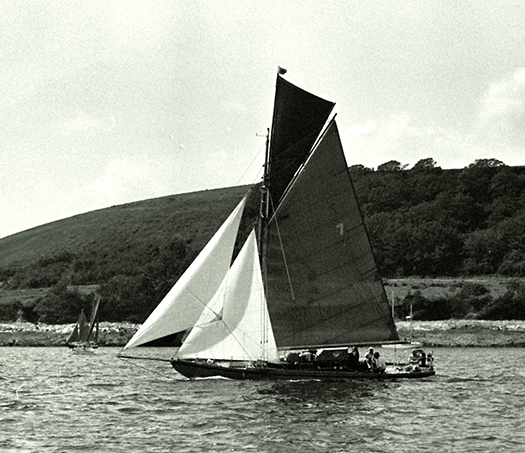
Tern in Falmouth, July 1990. Rot had long since set in within her long and elegant Fife counter, so it had simply been chopped off. Photo: W M Nixon

Tern being overcome by the heat in Andraitx in Mallorca, October 2012. Photo: Patricia Nixon
Yet by 1947 according to Lloyds Register she was in Dun Laoghaire, owned by two members of the National Yacht Club, C E Hogg and M Healy. And then she turns up in Falmouth Harbour in the 1970s and stays there for some time, but she was restored to being a cutter, not with full rig but her mizzen had to be done away with, as there was rot in her long elegant Fife counter, so it was simply chopped off to become like a Laurent Giles stern.
It was then in a little yard in a hidden creek off Falmouth Harbour that she had her first major restoration, and with that she went to the Mediterranean. But by the Autumn of 2012 she was seen in Andraitx looking a bit sorry for herself, and very much for sale. And there she was bought and taken into the specialist yard in Palma, and at the end of December 2014 Patricia O'Connell and Alan Renwick turned up in Ireland and began a pilgrimage.

Alan Renwick and Ian Malcolm aboard the latter's Aura in Howth, December 30th 2014. Aura had Tern have just one year age difference, but the same builder. Photo: W M Nixon
This took them to Howth to see the Hilditch-built Aura (like Tern, she's number 7, and like Tern, at one time her mainsail was mixed up with a number 2). Then it was down to Crosshaven to meet Royal Cork archivist Dermot Burns, who was a fund of information and original material abut Tern's twenty-plus years on Cork Harbour. Then on north to Belfast Lough for a large gathering in the Royal Ulster, a party built around the Charley family, one of whose ancestors owned Tern in 1910, and also brought in folk like noted northern sailing historian Michael Clarke of Lough Erne, and Fife yachts historian Ian McAllister who now lives in Carrickfergus. So you can well imagine that information and ideas overload was a constant risk. But Patricia and Alan survived, they got back to Palma in one piece, the work on Tern resumed, and the Tale of Tern goes on.

There's a Fife hull in there somewhere. Tern in the restoration shed in Palma
Giles Scott Joins Ben Ainslie Racing, Eighth Sailor to Join British America's Cup Team
#bar – Anyone who followed the build-up to the 2012 Olympic Games will remember that the biggest hurdle to Ben Ainslie's historic fourth gold medal was another Brit by the name of Giles Scott.
Their rivalry was one of the most compelling stories of the lead-up to the London 2012 Olympics – a classic narrative as Scott, the apprentice and former training partner, attempted to unseat the dominant figure of the previous generation, and win the single Team GBR place at the Games.
History records that Ainslie won selection, and then won his fourth gold medal. But Giles Scott used his time wisely; he raced with Luna Rossa in their 2013 America's Cup campaign, and this summer won the Finn Olympic Class World Championship in Santander. Scott is now a firm favourite for gold in Rio 2016, and will be a key member of the British America's Cup team, Ben Ainslie Racing.
Their story began much earlier than most people realise, right back when Scott was a talented junior.
"The first time I met him was years and years ago," recalled Scott when he came in to the BAR offices to sign his contract. "I was doing a National Junior event. I was with the Northampton team, and Ben came and did a talk. I think I would have been about ten years old, sailing with my older brother. I didn't talk to him, but I think I got a sweater signed by him!"
"We crossed paths at various events after that," he went on, "but it was when I started sailing the Finn (the Olympic class boat in which Ainslie won his final three gold medals) that I really got to know him. It was 2006 when he came back to the boat – after two years away – to prepare for the 2008 Games. I was one of the youngest members of the Finn squad and still at University, and Ben was the figurehead."
Ainslie remembers that time clearly. "It was a lot of fun because they were talented guys who were enjoying learning to sail a new class of boat, and for me it was refreshing having some young, motivated guys there to train with – so it worked very well. And Giles was the stand-out talent of that group." Scott was the ISAF Youth World Champion in the single-handed class in 2005. "They didn't really have any expectations of the 2008 Olympics," added Ainslie, "but then with me moving away into the America's Cup, it was a different story when I came back in 2010. They were that much older, and really going for the 2012 Games."
Thanks to the idiosyncrasies of the Olympic rules, only one person per nation can compete in each of the ten sailing events. Ben Ainslie and Giles Scott were — by any reasonable measure — the best two athletes in their class in the world. Scott was World Champion in 2011; while Ainslie was World Champion (for the sixth time) in 2012. But because they were both British, only one of them could go to the Games.
"The thing is about Giles," said Ainslie, "he's a really nice guy, and I remember saying to him in the build-up to 2008 that it's great to be nice, but you also have to learn to stand-up for yourself and not let people push you around. Of course, he'd really taken that to heart and so it was a slightly different story for 2012 when he was going for the Olympics. And quite rightly, he needed to stand up for himself. He had just as much right as anybody else to that spot."
"There was a switch in my mentality," said Scott. "I had to switch from having Ben on a pedestal, to seeing him as a competitor that I wanted to beat. There was no switch in the way that we operated off the water, but on the water there was a definite transition. He was always trying to assert the dominance that he had always had, and I was constantly trying to break that down."
The two men went head-to-head in the events that Team GBR had defined for the selection process. "I won a lot of the events in the build-up to the start of the selection events," reflected Scott, "and then [when it came to the selections] Ben was at the top of his game and he ticked all the boxes, while I finished second." The rest is history, Ainslie got the spot on the British team, went to the London Olympics and, under almost unimaginable pressure, won his fourth gold.
"The one good thing that came out of it was that it opened up the America's Cup doorway," commented Scott. He started sailing with Team Korea, and then Luna Rossa offered him a place on their sailing team.
"All the guys you speak to at Luna Rossa only have good things to say about Giles and how he fitted in with the team," said Ainslie. "And that's one of the reasons why we wanted him to be part of this team. There are a handful of sailors of his generation in the world that stand out as really a cut above the rest, and Giles is clearly one of those. We have been very selective about the people that we have brought in; we know that they will gel with the team. And with Giles, it was a 'no-brainer'. A good team player and a winner. We are very excited about him being with us."
Scott has continued where Ainslie left off, and now dominates the single-handed men's Finn class, recently winning the 2014 World Championships with clear blue water between him and the pack. It's obvious that Scott has unfinished business with that Finn gold medal, and doesn't intend to let it slip away again.
Combining America's Cup sailing with the Olympics is something that Ainslie knows all about, but how does Scott think he will fare? "I'm hoping it will be easy to integrate the two, and achieve my Olympic goals and have a positive impact on the Cup. It's an amazing project to be involved in. I'm just feeling very excited about getting my teeth into it and trying to make it all happen."
Stephen 'Sparky' Parks, RYA Olympic Manager, agrees joining BAR is a positive move for Scott, "Joining BAR is a great option for Giles. No one understands what it takes to win an Olympic medal better than Ben Ainslie – and that will help to ensure that Giles gets the job done in Rio before focussing exclusively on the America's Cup. Giles will be able to draw on Ben's experience to ensure he keeps the Finn Olympic Gold medal in GBR hands, where it has been since 2000. Equally, Ben knows Giles well, and he knows he will bring a host of raw sailing skills to the BAR programme."
And what about working with Ben after all those bruising encounters on the water? "It's very useful to have been through that, because if two people were ever going to fall out over something, it would be over an Olympic selection – you are battling each other for your dream. Going forward from that, I have a knowledge of him and how he performs – what he likes, what he doesn't like – you just know each other, so I think it can only be a positive thing," concluded Scott.
Giles Scott – Fact file
Date of Birth: 23rd June 1987
Place of Birth: Huntingdon
Current Home: Weymouth
Major Titles: ISAF Youth World Champion 2005; Finn World Champion 2011 and 2014; Finn European Champion 2011 and 2014; Rio Olympic Test Event 2014.
America's Cup Deserves the Nobel Peace Prize
#americascup – The America's Cup is still sailing's sacred monster. More so than ever, in fact. And it is still something of which we can honestly say: "This is the peak of world sailing – alas". But after the fantastic 34th America's Cup series in San Francisco, there's no denying it has us hooked.
How can we be so sure? There's a simple test. Anyone who took the slightest interest in it now asks: "What happens next?" Once you're getting that response from people, whether they are sailors or sports fans or simply good old Joe Public who just happened to catch it on a news flash, then you've got them hooked, and you can build on that for the future of the event.
So from being something which was only the highly specialised interest of an elite minority, it has become a supercharged happening from which everyone can take something. My own conversion came not from contemplating the seemingly endless intrigues which surrounded the event, and not from its extraordinary history of larger-than-life characters and even more off-the-wall boats, but simply from watching the vids of the giant catamarans racing, just like anyone else in an increasingly rapt global audience.
It's amazing to think that in a couple of years time and probably much sooner, we will take it for granted that a machine like Oracle USA can be powered up to sail to windward at 32.5 knots. And that done in a true wind of 17 knots. It meant that those on board were experiencing an apparent wind of upwards of Force 10.
And as for the way these 72ft boats rose on their foils, we may have had glimpses of it in the preliminaries, but when it is happening as a regular occurrence you begin to feel you're not looking at a boat at all, but at an utterly sensational magic carpet. Sailing became three dimensional as they shook off the grip of the sea. One can only reflect that the great G L Watson, who was the first designer to become obsessed about the need to reduce wetted area, would have been ecstatic.
And all this technical stuff is over and above the basic human interest, and the allocating of credit where credit is due. For sure, the introduction of Ben Ainslie as tactician into Jimmy Spithill's Oracle USA team made a significant difference. But it's pitching it a bit high to say that Sir Ben saved the America's Cup for Larry Ellison. Rather, he was a major component in a complex process of continuous improvement in every area, in a campaign which cleverly utilised every opportunity for scrounging extra time in order to maximise the boat's performance and thereby upset Team New Zealand's seemingly unassailable points lead.
Thus any sailor with an under-performing boat can take encouragement from the fact that when the finals began, the Kiwi boat was simply out-performing Oracle. But in the nail-biting final race, after endless round-the-clock work on the American boat, the reverse was true. Tactically, it was the New Zealanders who were on top of the game to establish an early advantage in that final race. But once they were fully into the beat, Oracle simply sailed round them and on into a solid lead.
That it's suggested that this turnaround is something which can be an inspiration to any sailor may seem far-fetched when we consider just how remote the America's Cup catamarans are from the kinds of boats and the sort of sailing the rest of us enjoy. But that is the measure of this series – there was something in it for everyone.
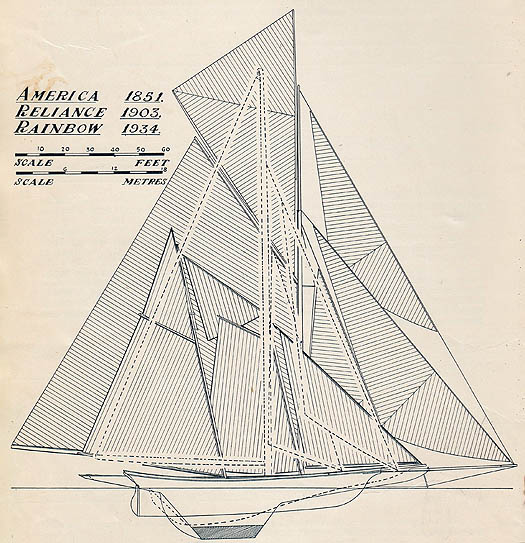
Three America's Cup winners, all to the same scale. Reliance of 1903 was the largest boat which has ever raced for the cup. At 143ft LOA, she was just one foot short of being twice the length of the current class of catamarans.
Not least of the impressions it leaves is the completely supra-national nature of it all. This genuine globalisation of sport is surely for the ultimate good of mankind. Officially it was New Zealand challenging America for an international trophy which originated in Britain 162 years ago. But what we might call the America's Cup community is now a supra-national grouping of hyper-talent drawn from many corners of the globe. Just which ensign goes up the winner's flagpole at the conclusion of the event depends on the nationality of whoever is signing the cheques. But the sailors themselves are patriots for their sport rather than the representatives of some narrow jingoist concept of nationality.
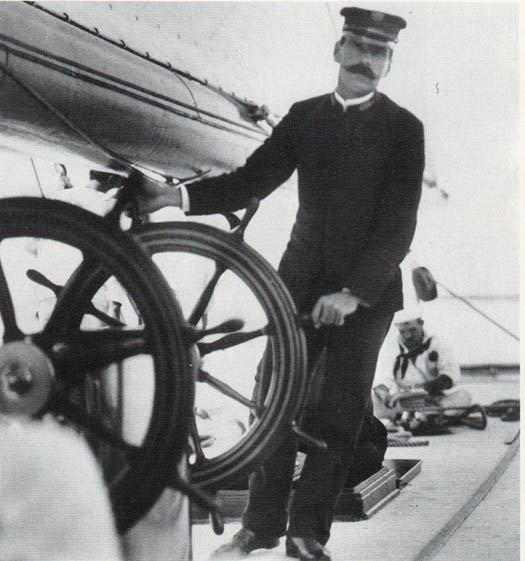
The main man. Charlie Barr on the helm of the giant Reliance, which had double wheels for extra power when needed. Barr was a Scotsman who became American as his sailing career reached the heights.
This is something which has long been central to the America's Cup, and it's all the better for it. After all, one of the greatest skippers in the history of the trophy was Charlie Barr, a Scotsman who settled in America after he had delivered a Clyde-built yacht across the Atlantic, and reached his full potential sailing American defenders of the cup.
More recently the Swiss involvement in the series emphasised just how meaningless traditional concepts of nationality can be. That said, we still do need some notion of nationhood in order to give us a better understanding of the human condition. The America's Cup's ability to transcend national feeling, while at the same time feeding a sense of national pride, is a remarkable achievement. It may seem a crazy idea, but why not consider it for the Nobel Peace Prize?
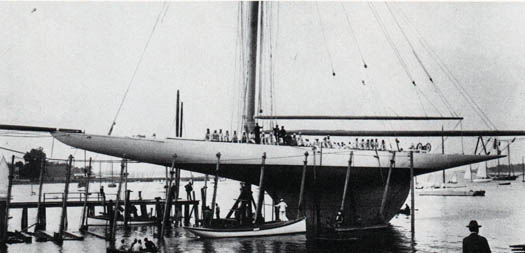
Launching day for Reliance, which carried a racing crew of 60......
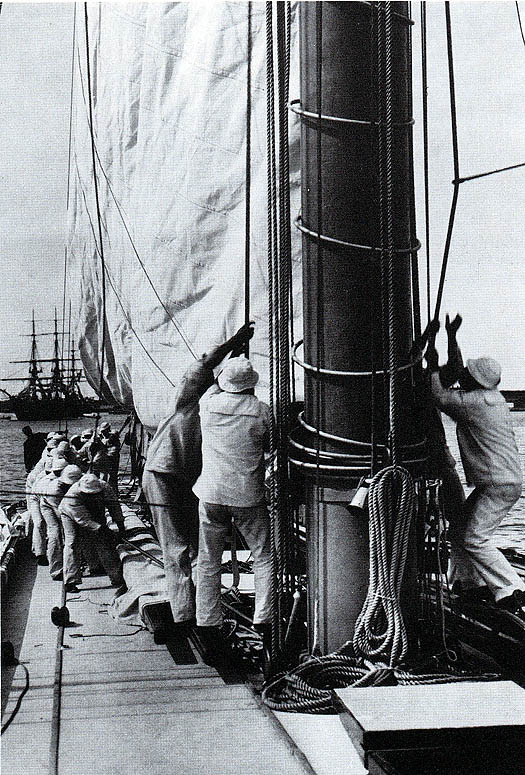
....and even with them all at work, hoisting Reliance's mainsail took quite some time. After defeating Thomas Lipton's Shamrock III by 3-0 in 1903, the Cornelius Vanderbilt-owned Reliance was dismantled, as her hull was built in so many different metals that it is said she hissed when put afloat.
As for its place in the global sailing community, it is currently very secure. We can't be certain that some future series will not draw the cup and our sport back into discredit, but for now we can be confident that the America' Cup has fulfilled all the hype, and then some. And by being something which is at a stratospheric height by comparison with almost all other forms of sailing, it now has the odd effect of making ordinary sailors feel more in community with the rest of the world. We reckon the America's Cup is just as crazy as everyone else does. But it certainly has got us hooked.
Baltimore's Revelin Minihane Lifts the America's Cup
#americascup – West Cork Commodore's Cup sailor and 1720 crew and former Mirror world dinghy champion, Revelin Minihane (right), who is also a helmsman with Baltimore RNLI lifeboat, proudly holds the America's Cup aloft during celebrations in San Franciso. As well he might, he has been a member of Team Oracle for five years. Minihane is pictured here with team mates in post regatta celebrations.
Minihane, who hails from from Skibbereen, went to school in Schull Community College. He sailed as crew for Marty Moloney of RCYC to Mirror World Championship success in South Africa in 1999. A former Fastnet Schools regatta winner, Minihane served as bow man for Anthony O'Leary on Antix in the 2006 Irish Commodore's Cup team. He has numerous 1720 Regatta wins to his name sailing with Nicholas O'Leary. He went to the RC44 circuit with Russell Coutts in 2008 and from there on to Team Oracle in 2010, tasting America's Cup success this week.
Americas Cup Comeback, Team ORACLE USA Wins Again...Now 8-6
#americascup – Is this the greatest sporting comeback of all time? The elusive match point for Emirtates Team New Zealand was again out of reach in San Francisco today. And as Oracle crossed the finish line ahead, the longest America's Cup in history was set to continue for another day.
Only one race was sailed after the start was delayed for 30 minutes and it produced another win for Oracle.
Skipper Dean Barker said the team was ready for another race this afternoon but again the weather called the shots. The delay meant the race committee ran out of time to run a second race.
NZL5 has sat on match point for five days as a vastly improved Oracle has chipped away, winning five races on the trot.
Baker was upbeat after racing: "We don't want to trade positions. We would still rather be on match point," a reference to the points table, led by Emirates Team New Zealand by eight point to six. Nine points are needed to win the America's Cup.
"It's a battle and Oracle has stepped it up a lot. We are racing against a boat that is much better than when it first started.
"It has been a rough road the last couple of days. It is very, very close. We have to sail well, get ahead and win. We are motivated to work even harder to make sure we do finish this thing off."
Tomorrow's forecast is for winds at the upper end of the range.
Standings (first to 9 points wins)
Emirates Team New Zealand - 8
ORACLE TEAM USA - 6
Race 16 performance data
Course: 5 Legs/10.21 nautical miles
Elapsed time: OTUSA - 30:43, ETNZ - 31:16
Delta: OTUSA +:33
Total distance sailed: OTUSA - 11.8 NM, ETNZ - 11.7 NM
Average speed: OTUSA - 23.21 knots (27 mph), ETNZ - 22.46 knots (26 mph)
Top speed: OTUSA - 38.05 knots (44 mph), ETNZ - 36.61 knots (42 mph)
Windspeed: Average - 12.0 knots, Peak - 14.1 knots
Number of tacks/gybes: OTUSA - 10/10, ETNZ - 10/10
America's Cup Race Postponed Again, Oracle Foil Kiwi Plans With Second Win
#americascup – Another one-race day at San Francisco as wind and tide conspired against the race committee's best endeavours to get the second race away.
They came close to succeeding. The boats were well into the two-minute start sequence when the plug was pulled for the third day in succession.
Emirates Team New Zealand started today one point away from taking the America's Cup to New Zealand.
The team ended the day in exactly the same position as it started it, but with a win in the one race sailed, Oracle put another point on the board.
The team lost race 12, the only race to be held today. Oracle gained another point and now trails New Zealand eight points to two. The first team to nine wins the America's Cup. Oracle won the start and led to the finish. The delta was 31s.
Standings (first to 9 points wins)
Emirates Team New Zealand - 8
Oracle Team USA - 2




























